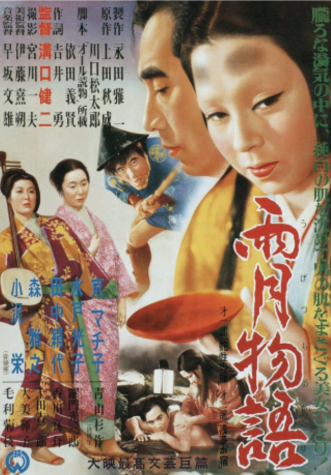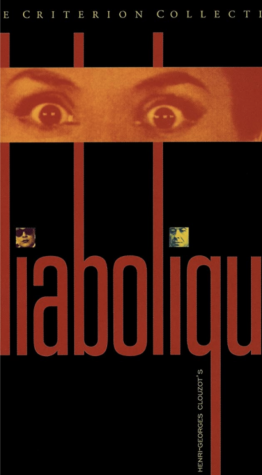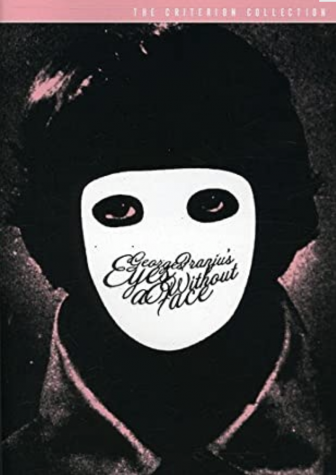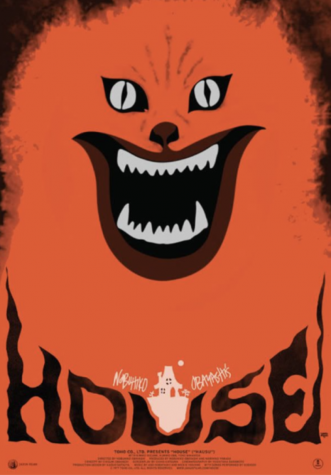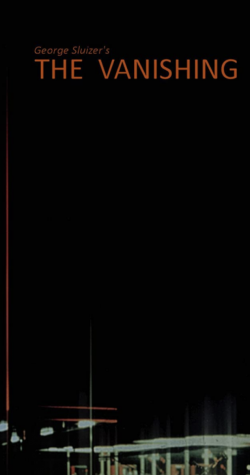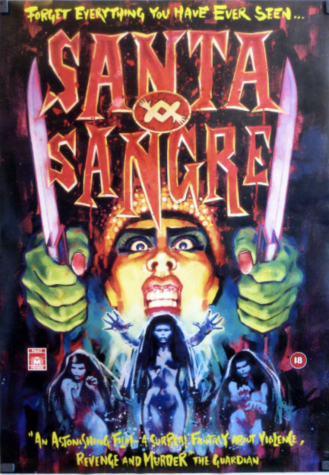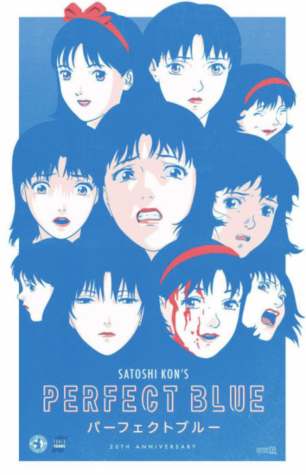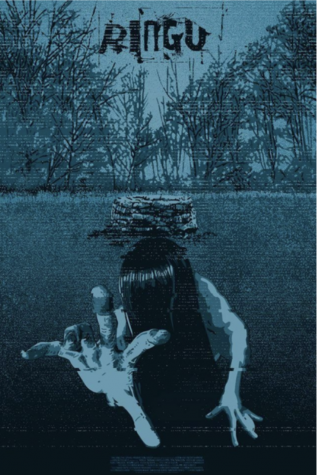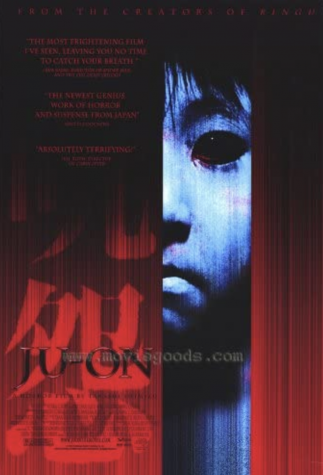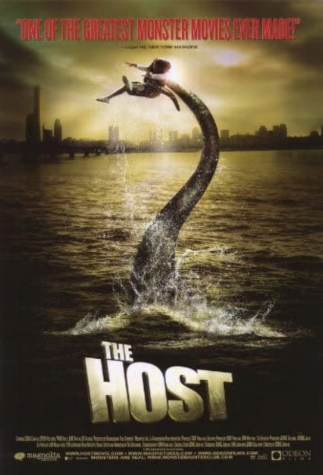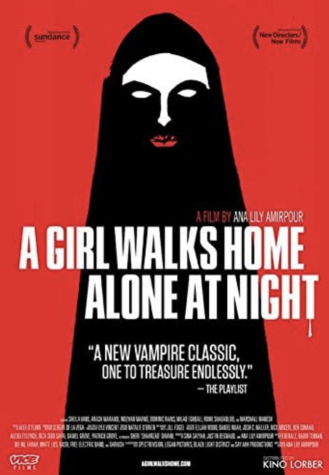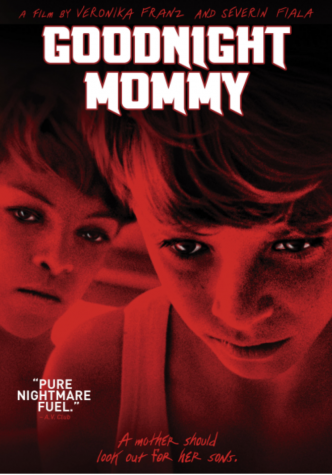Through the decades
Foreign language horror film guide
May 12, 2020
“Tiger King” and “Ozark” might be getting all the love as Americans turn to streaming services more than ever before, but it’s time to recognize and appreciate some important movies from around the world—specifically, horror movies. That’s right, flicks that make nightmares, frighten children and send you and your popcorn flying off the couch. If you have access to any of these streaming sites—Amazon Prime Video, Hulu, Kanopy (free to all Case Western Reserve University students), Vudu, Tubi (free), iTunes, Google Play, the Criterion Collection or YouTube—then this list will add a splash of structure to your quarantine movie-watching experience. Even more than that, if you want to be able to call yourself a “horror movie buff,” this is a guide to some of the most influential foreign-language horror films since the 1950s, representing Japan, South Korea, France, the Netherlands, Iran, Mexico, Italy and Austria.
Not only will you want to see all 14 of these films because they helped shape modern horror cinema, but hopefully you’ll learn a bit about the growing number of directors helping to diversify this underappreciated genre, as well as mainstream moviemaking, without losing too much sleep along the way. So grab a snack, find a loved one, turn off the lights and take a trip down the dark trail of foreign horror cinema.
“Ugetsu” (Kenji Mizoguchi, 1953) (Trigger warning)
Streaming: Amazon Prime Video, Kanopy, iTunes
This Japanese ghost story from 1953 directed by Kenji Mizoguchi is a wonderful place to start on this guide through horror by decade because “Ugetsu” establishes many tropes and motifs of later films while also being on the softer side of the genre. The word “ugetsu” symbolizes a night with a misty moon, literally meaning “rain-moon.” The film is a jidaigeki, or “period drama,” with the backdrop of feudal Japan amidst war. “Ugetsu” tells the tale of two men who forsake their wives by making terrible mistakes. One man is corrupted by his own vanity and the other is seduced by a beautiful and terrifying spirit. There is a small amount of sexual violence in the film, though it is more implied than shown. “Ugetsu” is a black-and-white classic of Japanese cinema for its beautiful cinematography and clever writing. Though it is not altogether a horror movie, there are many elements of this drama that are horrifying, including ghost women, haunted waters and psychological torment. While this film is a drama at heart, the Japan that “Ugetsu” depicts is riddled with mysticism and supernatural beings that are ominous enough to provide a good lasting scare. “Ugetsu” is, more than anything, a spectacle that is pleasing to watch and says a lot about early Japanese cinema and Asian takes on ghosts and folklore.
“Diabolique” (Henri-Georges Clouzot, 1955) (Trigger warning)
Streaming: Amazon Prime Video, Kanopy
“Diabolique”—translated to “The Devils”—was directed by Henri-Georges Clouzot in 1955. It is a French horror thriller starring Simone Signoret and Véra Clouzot that is based on the novel “She Who Was No More,” written by Boileau-Nercejac. As a woman and her husband’s lover plot to murder him, things take a turn for the unexpected and, potentially, the supernatural. There is also a small amount of sexual violence involved that pushes the suspicious wife to consider the evil deed that she eventually commits. This film was foundational for many of the structures of Hollywood horror cinema in the ’60s and ’70s. “Diabolique” inspired Alfred Hitchcock’s “Psycho,” as well as several whodunit films. Psychological horror is ever-present throughout the film, interwoven with clever dialogue and stunning imagery. “Diabolique” is an early example of murder mystery horror and the use of a major plot twist. Even the film’s credits urged viewers not to let others know what happens at the end. With cinematography like an Orson Welles film and a dash of Hitchcockian suspense, what’s not to love about this wild mystery? “Diabolique” is purely an experience made for the cinema and best watched with friends—or whoever you’re quarantined with—so that you can all be shocked together at the horror and surprise of the twisty narrative.
“Eyes Without a Face” (Georges Franju, 1960)
Streaming: Amazon Prime Video, Kanopy
With Georges Franju’s “Eyes Without a Face,” we now get into the grittier and darker horror films of the ’60s. This French film from 1960, directed and co-written by Franju and starring Pierre Brasseur and Alida Valli, is a terrifying story about a father whose daughter’s face is disfigured in a horrific accident. Unable to cope, he kidnaps another young girl and attempts to surgically graph her face onto his daughter’s to restore her beauty. There are no ghosts or quirky murder plots in this film. Franju’s screenplay deals with kidnapping, body horror and pure terror in ways never before seen in horror cinema. The script is surprising to say the least, and is shrouded in an eerie style that is reminiscent of German expressionism while also foreshadowing much of the edgier aesthetics of horror to come. The use of practical effects, (physical as opposed to digital or illusory effects) was groundbreaking in this film, and it serves as an extremely early model of the body horror subgenre. Following “The Blob” in 1958, arguably the first body horror film, and leading to a body horror breakthrough with 1962’s “The Brain That Wouldn’t Die” and the pinnacle of the subgenre with 1982’s “The Thing,” this film is a must see for any fans of practical effects in horror cinema.
“Onibaba” (Kaneto Shindô, 1964) (Trigger warning)
Streaming: Criterion Collection, YouTube (free)
“Onibaba”—translated to “Devil Hag”—is another jidaigeki on this list, though it is far darker and more terrifying than “Ugetsu.” Directed by Kaneto Shindô in 1964, this Japanese horror film takes place during a civil war—one that two women use to their advantage. Nobuko Otowa and Jitsuko Yoshimura play the two women who murder soldiers in order to steal from their dead bodies. However, their luck turns sour when they steal a possessed demonic Oni mask from a particularly strange soldier. Upon wearing the mask, one of the women begins experiencing terrifying symptoms. This film was the first of Shindô’s to focus on the issues of women in Japanese society, showing them as victims of obsessive desire and rape. He would later make more films in the same vein. Similar to “Ugetsu,” this film portrays the faults of mankind and uses the supernatural to punish its characters and teach a valuable lesson. However, “Onibaba” is particularly stunning in its visuals and its well-crafted elements of horror. The use of silence and suspense in this film is so efficient that you will be grinding your teeth in anticipation and fear. “Onibaba” is also stylized differently than “Ugetsu.” It is extremely raw, gritty and it gives off more of a serious tone that makes the supernatural far more threatening. “Onibaba,” as well as other Japanese horror films from the time, laid much of the foundation for future horror involving demons and possession. There is a scene near the film’s end that could have found itself in 2013’s “The Conjuring.” Like many films on this list, “Onibaba” was ahead of its time and more than worthy of being queued up for late-night viewing.
“Suspiria” (Dario Argento, 1977)
Streaming: Kanopy, Tubi (free)

“Suspiria,” directed and co-written by Dario Argento, is an Italian psychological and fantasy horror film spawned from the era of Giallo films—heavily stylized Italian slasher films—that ultimately led to what we know as the slasher genre. Movies like Mario Bava’s “Bay of Blood” and Argento’s earlier “Deep Red” established the Technicolor nightmarish aesthetic that defined this era of horror. The script was based on a collection of essays by Thomas de Quincey called “Suspiria de Profundis,” which is Latin for “Sighs from the Depths.” The film follows Suzy Bannion, played by Jessica Harper, as she travels to a prestigious German dance school deep in a treacherous forest that is run by witches and drenched in vibrant palettes of evil. The film, though often criticized for its simple plot structure and unnecessary exposition, is an art piece with cinematography that was unprecedented in global cinema. Every scene is full of gothic set pieces mixed with dramatic silhouettes that are bathed in red, green and blue. The soundtrack to the film, done completely by the Italian progressive rock band Goblin, is relentless, yet beautifully satisfying, as it mixes prog rock with jazz, folk and a horrific atmospheric soundscape. The film is a tour de force of blood, screams and neon lights without a dull moment in sight. If you can look past the lackluster writing, “Suspiria” is an over-the-top spectacle that is bound to mesmerize you each time you watch it.
“Hausu” (Nobuhiko Ôbayashi, 1977)
Streaming: Amazon Prime Video, Tubi (free), Vudu, iTunes, Criterion Collection
“Hausu,” released as “House” in the U.S., is absolutely the strangest and most outrageous film on this list. Nobuhiko Ôbayashi’s 1977 psychological Japanese horror comedy is marvelously experimental and artistic in all elements of filmmaking. The film follows seven schoolgirls as they are each attacked by a haunted house. However, this small description says nothing about the insanity that is unleashed in the film. There is simply nothing like “Hausu,” a stylistic gem of originality beyond comparison. There are bizarre practical effects like talking flying heads and paintings of cats spewing blood. There are plenty of scenes that utilize the layering of colored art over film to create psychological sequences with ghosts, cats, ghost cats and a piano that will devour you. You can’t make this stuff up, unless you are screenwriter Chiho Katsura, who also wrote Obayashi’s film “Hanagatami” in 2017. This film is loads of fun and is an art piece that will leave your jaw on the floor and your brain wondering “What just happened and why have I not seen this before?”
“The Vanishing” (George Sluizer, 1988)
Streaming Amazon Prime Video, iTunes, Kanopy
“The Vanishing” is a 1988 Dutch thriller that takes place in the mountainous regions of France and the Netherlands. Directed and co-written by George Sluizer, this film is well known for having one of the most haunting endings of any horror film in the 20th century. The story, adapted from Tim Krabbé’s novel “The Golden Egg,” is a sad tale about a man named Rex (played by Gene Bervoets) who searches for three years for his missing wife, Saskia (Johanna ter Steege), who was abducted at a gas station while they were on holiday. The film is a slow-burn drama turned thriller as Rex comes closer and closer to learning the truth about Saskia’s fate, though when the truth presents itself, it’s the greatest horror of all. In “The Vanishing,” the most potent horror element is the audience’s ignorance. It is the array of possible endings, twists and turns that will keep you awake for nights after your first viewing. The soundtrack by Hennie Vrienten is chilling and the cinematography is gorgeously conceived. With this film, Sluizer achieved a thriller that is too real for many to stomach, but is too intriguing to ever look away from.
“Santa Sangre” (Alejandro Jodorowsky, 1989) (Trigger warning)
Streaming: Amazon Prime Video, Vudu, iTunes, Google Play, YouTube
“Santa Sangre”—translated to “Holy Blood”—is not for the faint of heart. This 1989 film was directed by Alejandro Jodorowsky and co-written and produced by Claudio Argento, brother of Dario Argento, who directed “Suspiria.” Claudio Argento absolutely brought the visceral style of his brother’s Giallo films from Italy for this Mexican film. Just like its predecessors, “Santa Sangre” is flooded from beginning to end with bright colors, bizarre characters and lots and lots of blood. This film, however, is more avant-garde than early Italian horror and it also has a far better script than anything Dario Argento directed. The story follows Fenix—played by Axel Jodorowsky—a young boy who grows up in the circus with a rapist knife-throwing father and a psychotic mother who is also a bilateral amputee … I know, it’s pretty crazy, but things get much worse for Fenix as the film follows his life and his descent into chaos. “Santa Sangre” is a violent and extremely graphic film with scenes of rape, dismemberment and other disturbing violence. Despite its harsh content, it makes the list for being a stellar entry within the post-Giallo subgenre and having a script that is original and executed with gorgeous style and cinematography. Skip this one if you have a weak stomach or if you need to avoid certain content. Otherwise, it’s an energetic film that is unforgettable.
“Perfect Blue” (Satoshi Kon, 1997) (Trigger warning)
Streaming: Amazon Prime Video, Google Play, YouTube
“Perfect Blue” is a 1997 animated psychological horror film from Japanese director Satoshi Kon. The film was originally supposed to be live action until the Great Hanshin earthquake of 1995 dropped Kon’s budget, forcing the director and his team to opt for the cheaper production costs of animation. They did not, however, predict how much this would improve their movie, as “Perfect Blue” has gone down as one of the greatest animated horror movies of all time, inspiring the later American film, “Black Swan.” The film follows Mima Kirigoe, voiced by Junko Iwao, a bright-eyed superstar who rises to fame in a Japanese pop idol group singing with two other girls. Mima decides to leave the group to pursue acting and, while she excels in her new profession, she is tormented by her past self, who appears to her in nightmarish visions as well as in real life. All the while, she is stalked by a psychotic superfan with hellish intentions. Keep in mind that the animated medium gave the script far more liberties with things like gore and sexual violence. Kon’s film also tackles huge themes like fame, Hollywood, voyeurism and the deterioration of the mind in a story that is gripping and utterly heartbreaking. “Perfect Blue” is a stunning masterpiece of writing and animation. The animated style allowed the psychological horror elements to reveal themselves in ways far more terrifying than a live action film ever could. “Perfect Blue” serves as a testament to the untapped potential of film animation and proves that animated horror should be treated with the same respect as live action blockbuster thrillers and monster movies.
“Ringu” (Hideo Nakata, 1998)
Streaming: Amazon Prime Video, Kanopy, YouTube, Google Play
“Ringu,” directed by Hideo Nakata in 1998, is a Japanese supernatural horror film about a mysterious tape that, when viewed, promises to kill you one week later … and succeeds. The film spawned a few sequels and an American remake that saw its own sequels as well. Despite Naomi Watts’ wonderful performance in 2002’s “The Ring,” the American version is outshined by “Ringu’s” terror and originality. This film popularized the horror trope of the creepy girl with long black hair, specifically one who crawls out of your TV. The use of meta-narrative in the script—through paralleling the movie-watching experience with the viewing of the cursed tape—is a source of immense dread and horror in this insanely intelligent film. Stylistically, the film uses the structure of a crime narrative following a reporter and a series of murders to overlay the supernatural underbelly of the story in a way that makes the film even more intriguing. To say this film had an effect on horror cinema is an understatement, as a myriad of tropes, styles and inspired directors followed in the wake of the massive impact of this film. Watch at your own risk, because “Ringu” might leave you questioning whether the film is also watching you—and whether that girl in the TV is going to hop into your living room.
“Ju-On” (Takashi Shimizu, 2002)
Streaming: Amazon Prime Video, Tubi (free), Vudu, YouTube, Google Play, iTunes
Appropriately following “Ringu” is the horror classic, “Ju-On.” This film was directed by Takashi Shimizu in 2002, leading to sequels, American remakes—including “The Grudge,” which happens to be the first horror movie I ever watched—and a crossover with the “Ringu” series. The film is actually the third installment in the series, though the first two were direct-to-video and not normally recognized in relation to the film. “Ju-On” is a Japanese horror film that follows a cast of characters led by Megumi Okina and Misaki Itô as they run for their lives from the parasitic evil that inhabits an old woman’s home in Nerima, Tokyo. The evil spirits take the form of two pale children, a gentle young boy who meows like a cat and a malevolent young girl with long black hair that can grab at you, pulling you under bed sheets and into attics. The film cleverly sparks fear through claustrophobic cinematography and scenes that are crafted purely to terrorize. From the ominous clicking of tongues to strands of hair that appear where they shouldn’t be, this film is one of the scariest ever made. The music and imagery are eerie, forcing you to watch the second act through your fingers if you choose to see it at night. The script is intelligent and completely without a wasted line or a dull moment. Though the horror of pale ghost children has been numbed over time through the many sequels and parodies in films like “Scary Movie,” no amount of exposure can dilute the pure terror that hides in each scene of this film. “Ju-On” is a masterclass in horror filmmaking and a staple of Japanese horror cinema.
“The Host” (Bong Joon-ho, 2006)
Streaming: Hulu, Amazon Prime Video, Tubi (free), Vudu, YouTube, Google Play, iTunes
“The Host” is a South Korean horror film by acclaimed Oscar-winning director Bong Joon-ho. The film is considered a monster movie by some and a horror comedy by others. The movie follows Park Gang-du, played by Song Kang-ho, the star of Joon-ho’s highly popular 2019 film, “Parasite.” Park deals with the terror of a water monster that attacks his town and kidnaps his daughter. “The Host” uses the same balance of dark comedy and suspense that made “Parasite” the film of the year and the first non-English language film to win an Academy Award for best picture in 2020. The effects used for the monster—an enormous slimy beast that is somewhere between a frog, a fish and a snake—are realistic and impressive for 2006. At the heart of the screenplay are intriguing characterizations that will make you care for the characters while unraveling themes and providing commentary along the way. Gang-du is especially loveable and following his journey is both fun and rewarding. There’s a heavy emphasis on eco-awareness in this film, as the monster is the product of humanity’s carelessness with toxic waste. Joon-ho’s script, co-written with Baek Chul-hyun, was partly inspired by a true story of a Korean man who poured copious amounts of formaldehyde down his drain as well as a separate story about a deformed fish found in the Han River, where the film’s monster originates. “The Host” is highly entertaining and is a clean balance of stellar filmmaking with warranted campiness and an edge of terror.
“A Girl Walks Home Alone at Night” (Ana Lily Amirpour, 2014)
Streaming: Amazon Prime Video, Kanopy, Vudu, YouTube, Google Play, iTunes
2014’s “A Girl Walks Home Alone at Night” is considered to be the first Iranian vampire Western—yes, I said Western. Directed by Ana Lily Amirpour, this independent horror flick was filmed in Southern California and released in Persian. The story follows a young Iranian man, played by Arash Marandi, who runs into a young vampire woman played by Sheila Vand. The two get involved with drugs, prostitution, blood-sucking and the like. The dark and edgy content of the plot is tempered by a lighthearted indie aesthetic and an ’80s retro style. Skateboarding, slow-dance music and melodramatic acting make for some fun and memorable scenes in a rather dark film. The movie is also filmed in black and white. However, a friend of mine once considered this movie to be “the most colorful black-and-white horror movie” she had ever seen. This rings true due to the top-notch cinematography and impressive usage of a well-worn genre. Thankfully, unlike earlier films like “Santa Sangre,” this movie does not pander to fans of rape-revenge plots or the male gaze. “The girl,” as she is called in the script, walks home alone at night and those who happen to run into her are the ones made victims. It’s a great subversion of the genre while utilizing the symbolism of drugs, a trope that Abel Ferrara pioneered in 1995’s “The Addiction.” Amirpour provides fresh content in this film that has helped to revive my faith in the overworked vampire subgenre and modern horror cinema.
“Goodnight Mommy” (Veronika Franz and Severin Fiala, 2014)
Streaming: Amazon Prime Video, Tubi (Free), Vudu, YouTube, Google Play, iTunes
“Goodnight Mommy” is a 2014 psychological horror film co-directed by Veronika Franz and Severin Fiala. This Austrian thriller follows young twin boys as they grow suspicious of their mother who returns home from a surgery with a bandaged face and begins to act differently than before. Eerily distant and silent, the mother leaves the two boys to wonder whether they are overreacting to their new lifestyle or whether there is a stranger in their home disguised as their mother. “Goodnight Mommy” reflects the major shift in horror style and aesthetic that grew in the 2010s with other thrillers like “Shutter Island” and “Insidious.” In this era, the dark becomes darker and the jumps are jumpier, although “Goodnight Mommy” is not bogged down with clichés and overused pop-ups. The terror is instilled through anxiety, imagery, music and a dreadfully unnerving scenario within the plot. The acting is impressive from the two young co-stars and real-life twins Elias and Lukas Schwarz. They prove themselves as worthy protagonists and are able, alongside their mother, played by Susanne Wuest, to communicate so much character, information and dread through scenes with little to no dialogue. This film burns a bit quicker than “The Vanishing” and is a tough competitor for being one of the scariest films on this list. I leave that for you to decide.


